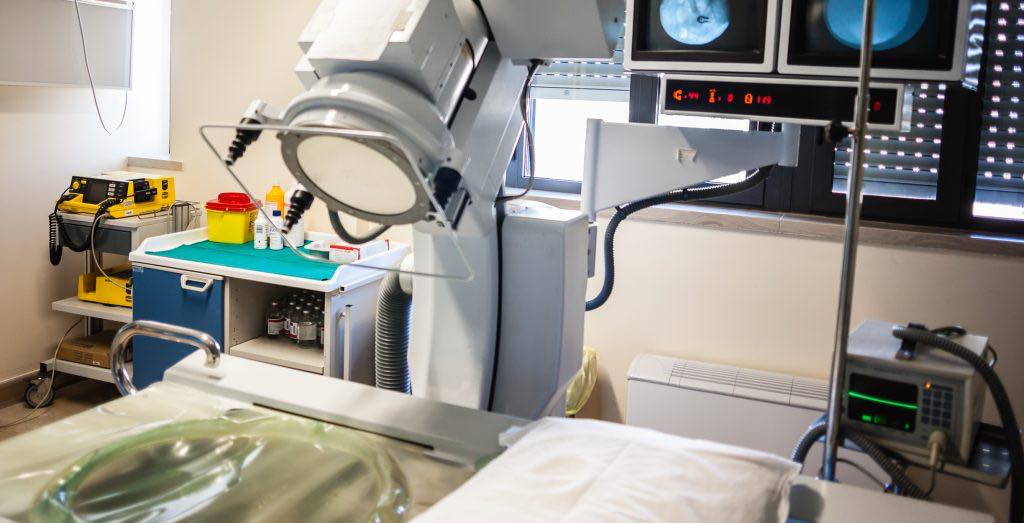A kidney stone is a hard mineral material that forms in either your kidney or urinary tract. Some kidney stones form because of a kidney infection, others because your body is producing too much of a certain mineral or because your body is experiencing a decrease in urine volume. The size of kidney stones can differ, ranging from a fraction of an inch to several inches. In extreme cases, kidney stones can become as large as the size of your entire kidney. The treatment options to remove kidney stones can vary, depending on their size.
Anyone can develop kidney stones, but there are some variables that cause them to develop in some individuals more than others. Age is one factor. In fact, most kidney stones develop in people between the ages of 20 to 49 years old and, once you’ve had your first stone, it’s more likely that additional ones will form. 40% of the people who get kidney stones have relatives who have them, too. Kidney stones are most common in men, people who are obese, and those that live with diabetes.
How are kidney stones diagnosed?
Some kidney stones are so small that they may not present any symptoms until they pass into your ureter. The pain from a kidney stone usually starts out of nowhere and, as it moves through your body, so will the location and intensity of the pain source. At this point there will be signs to indicate a problem which can include:
- Severe pain below your ribs, lower abdomen, and groin
- Fluctuating pain
- Pink, red or brown urine
- Nausea and vomiting
- Persistent need to urinate
- Fever and chills
If you suspect that you have a kidney stone, make an appointment with your doctor. First, it’s important to prepare yourself with questions about your doctor’s kidney stone removal methods. You have many options to deal with and to prevent a kidney stone. Be sure you understand the pros and cons of each treatment before you decide which kidney stone removal treatment you’ll use.
Here are some sample questions to ask your doctor about removing kidney stones:
- How long should I wait for my kidney stone to pass on its own?
- How much water should I drink to help a kidney stone move along faster?
- What foods should I eat and which ones should I avoid if I have a kidney stone?
- When is it time to take further medical action?
- What non-surgical methods for removing kidney stones can you perform and what are their recovery times?
- What is lithotripsy?
If your doctor suspects that you do have a kidney stone, there are several tests that can help determine your next steps:
- Blood tests can reveal if there is excess calcium or uric acid in your blood.
- A 24-hour urine collection test can show if you’re excreting too many stone-forming minerals or too few stone-preventing substances.
- X-rays and ultrasounds will show the actual kidney stones in your urinary tract.
Can you remove kidney stones without surgery?
Once your doctor determines that you actually do have a kidney stone, you’ll discuss the various methods to help it pass as quickly as possible. While you will experience discomfort during the process, it’s possible and extremely common to pass a kidney stone on your own within 48 hours. If it’s not too painful, your doctor may suggest that you wait it out and do the following things to help pass the kidney stone at home:
- Adding 2 tablespoons of apple cider vinegar to a glass of water can help dissolve kidney stones. Additionally, it’s known to help ease the pain.
- Pomegranate juice is not only delicious but it also improves kidney function by flushing stones and toxins from your system.
- Kidney bean broth is known to dissolve kidney stones. Just cook the beans, strain the liquid and drink it throughout your day.
- Dandelion root juice stimulates your body’s production of bile which helps eliminate waste, increase urine output, and improve digestion.
- Drinking 2 to 8 ounces of wheatgrass juice increases your need to urinate which helps to pass kidney stones. Wheatgrass is packed with many nutrients that help cleanse your kidneys.
- Do NOT drink any alcohol until your stone passes.
If you’re able to successfully pass a kidney stone on your own, you may want to save it to take to your doctor for testing. You can do this by using a strainer every time you urinate until it passes. Delivering your stone for further testing can help him develop a prevention plan for the future.
If your kidney stone becomes lodged, if you’re pregnant, or if the pain becomes too severe, a common procedure called lithotripsy is often used to remove kidney stones from your system.
What is lithotripsy?
Shockwave lithotripsy is the most common treatment to remove kidney stones in the United States. Before the procedure, your doctor will take x-rays or an ultrasound to confirm the exact location of your kidney stone. During lithotripsy, a high-energy sound wave that is placed outside of your body in order to break your kidney stone into little pieces on the inside of your body. The pieces will either pass on their own or your doctor may choose to put a tube (stent) into your ureter to help the process go faster.
After the lithotripsy is over, you should drink a lot of water to help flush out the remaining stones. This procedure is the most successful when treating small or medium stones. Because it is non-invasive with no cuts made in your skin, recovery from lithotripsy is fast and typically there is no overnight hospital stay.
What are the surgical options to remove kidney stones?
Sometimes, a kidney stone is too large to pass through your system without surgical intervention. When this is the case you’ll be in a lot of pain and be unable to urinate because the stone is blocking its flow. There are several procedures for your doctor to choose from to quickly move you forward in the process.
During a ureteroscopy, your doctor can reach the stone by inserting a thin, flexible scope through your ureter and bladder. It will then be removed by either a basket or by a laser breaking it up. Like a lithotripsy, no cuts are made in your skin and there is typically no overnight hospital stay.
For a larger stone, your doctor may perform a percutaneous nephrolithotomy or nephrolithotripsy. A thin tube will be inserted to either remove or break down your kidney stone. Either of these procedures may be inpatient and can require a 1 or 2-day hospital stay post-procedure.
Open surgery is an option for extremely large kidney stones. Because your physician will need to cut into your side and then your kidney, this surgery requires a longer hospital stay and can take up to 4-6 weeks for a full recovery. Fortunately, with modern technology, open surgery is becoming a less and less necessary treatment.
Most kidney stones will pass on their own. Fortunately, when they don’t, there are treatments to remove larger stones that do not pass easily. If you’ve suffered from kidney stones, you may be at risk of developing more in the future. Because of this, it is extremely important to stay hydrated to help prevent kidney stones from forming. It’s important to talk to your physician, ask questions and prepare to stay healthy before, during and after your kidney stone removal treatment.
Finding a fair price for your lithotripsy
Did you know the national average cost for lithotripsy is $19,000? New Choice Health takes the guesswork out of healthcare by allowing you to compare facilities and find a fair price to remove kidney stones. Use New Choice Health’s cost comparison tool to make a more informed decision and to save money on lithotripsy today.






